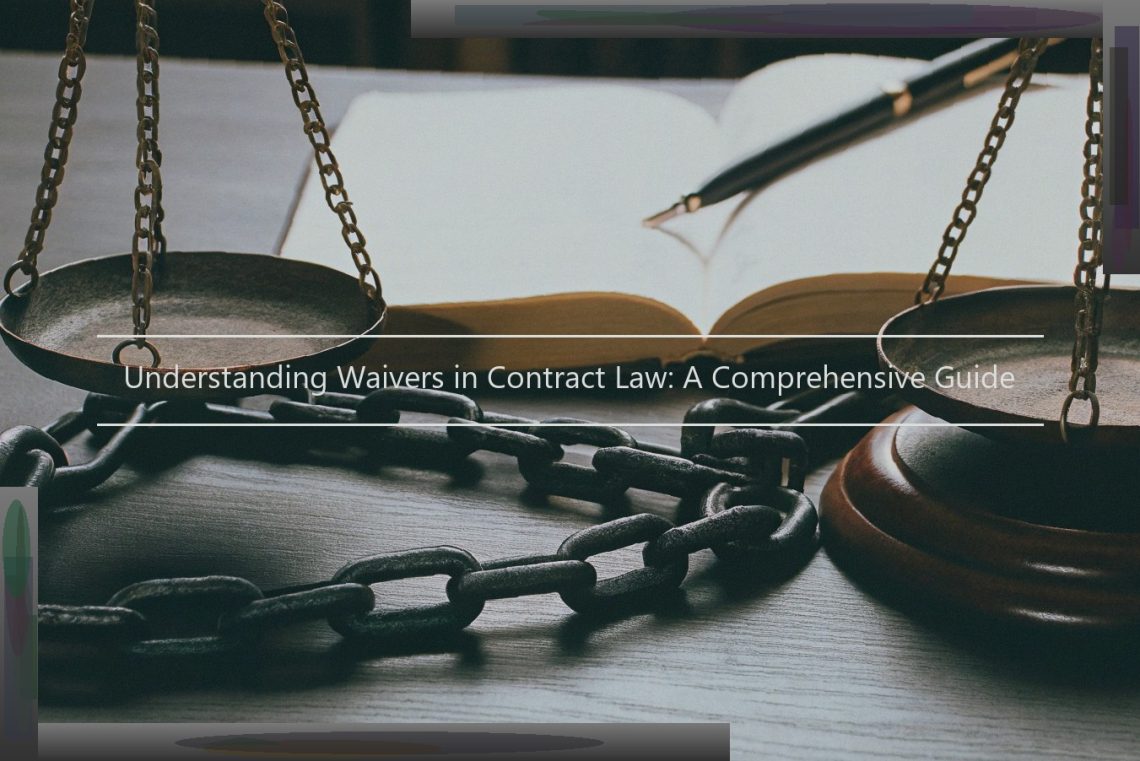
Understanding Waivers in Contract Law: A Comprehensive Guide
Waiver in Contract Law: Definition
A waiver in contract law is the voluntary relinquishment of a legal right through a clear and unambiguous act or statement, typically in relation to the terms of the contract. It is an intentional surrender of a known right, as opposed to a loss of a right because the party failed to exercise the right in a timely manner. Legal waivers can include the waiver of contractual or statutory rights.
From a legal perspective, a waiver has many important functions . For example, contract waivers can be used to add new parties to a contract, to forgive breaches or default, or to extend the time for performance without changing the terms of the original contract.
Waivers are most commonly used in legal agreements such as:
Waivers are often included as part of a contract, or they can be filed separately by the party forfeiting the right. In addition, waivers can either be fundamental to the contract or incidental to the contract. A fundamental waiver affects a key component of the contract, whereas an incidental waiver relates to a minor part of the contract.
Types of Waivers
Understanding the Different Types of Waivers in Contract Law
When evaluating a contract or a dispute arising out of a contract, one of the most important ways that you can protect yourself or adequately evaluate the claims is to understand whether a waiver has occurred. Waivers can arise by the parties’ conduct or agreement, and they are generally favorable to the party that was subject to a legal obligation, but they can also have harmful consequences for the obligor if they are not timely addressed. The easiest way to think about a waiver is in the context of forfeiture.
If I owe you $1,000 on Wednesday, and I don’t have the money on Wednesday, but on Friday I happen to get the money, and I give it to you on Friday, it won’t matter that you could have collected the $1,000 on Wednesday in court, because I paid you. The law does not care when you were owed the $1,000, just that you received it and that you are now whole. This is essentially what a waiver is: even if you had a right to collect against someone in court, you may lose that ability if you simply decide to take a payment later.
A waiver occurs when a party forgoes or gives up the right to address a failure to perform by another party. Waivers can occur by agreement—either express or implied—or by operation of the law. There are three basic types of waivers: (1) express waivers; (2) implied waivers; and (3) conditional waivers. We will discuss each type of waiver in turn.
Express waivers occur when there is a written contractual provision or other written instrument by which a party manifests its intent to forgo a right or remedy arising out of a breach of contract. For example, an express waiver may be contained in the terms of a note evidencing a loan made to a debtor or in the terms of a mortgage made to secure the loan. In most situations, you will be better protected by having an express waiver.
When a party provides an unconditional payment to satisfy a debt, the law will consider the unconditional payment to be an implied release of any claims that a party has on the debt if the parties had not agreed otherwise. If you make a payment to your mortgage lender as required under the terms of the mortgage, and then later it is discovered that the mortgage was not properly recorded, you will be precluded by the law from asserting this defense, because the performance of your contractual obligations—i.e., the offsetting of the debt—is generally more important than the technicalities of whether the mortgage was properly executed.
Conditional waivers are arguably the most hazardous actions that must be considered in connection with waivers in contract law, because it is nearly impossible to revive a lapsed right or obligation. If you pay off a debt, and the lender unconditionally accepts the payment but then later purports to go back and enforce your obligations under the mortgage, you will have a strong claim that you should be released from any further obligations under the mortgage agreement. Similarly, if you are presented with a conditionally accepted waiver, do not rely on it until it has been satisfied.
Examples of waivers frequently arise in the context of student loans, mortgages, and credit card agreements. Invariably, you will have these types of waivers in your life—make sure that you understand the implications of them before you sign your name.
Legal Elements for a Binding Waiver
A valid waiver is subject to certain legal requirements included in any enforceable contract. First, the waiver must be made by a party competent to do so. Second, under the concept of mutuality in contracts, both parties must have the legal capacity to waive their respective obligations. Third, there must be an intention to waive the obligation at issue.
Because contract law is based on the mutual consent of the parties, it stands to reason that mere silence on a matter will not suffice as a waiver. Similar to an express waiver, a waiver may be by implied act or conduct that communicates intent to abandon the legal right at issue. Additionally, a waiver is legally required to be clear and unequivocal. The understanding of the parties upon the waiver must be free from ambiguity and the language must be explicit, decisive, and superior to any other constructions of the waiver.
The fact that there has been a prior waiver of a legal right does not preclude the additional waiver of the same right; however, a party may be precluded from waiving the same right more than once. Additionally, a subsequent waiver cannot extend the time of performance of an obligation in a manner that increases liability.
While there are no hard and fast rules under contract law as to when the right to waive an obligation will lapse, this ultimately depends upon the type of right. The lapse in time can be lapse of the statute of limitations for the performance of the obligation, a specific date stated in the contract, or after a demand for the performance of the contract.
Impact of a Waiver on Performance Obligations
A waiver of a contractual obligation reflects a voluntary forbearance by a party to assert its rights under the contract and does not operate to actually terminate those obligations. Accordingly, waivers "do not ordinarily release from obligations properly assumed" or "destroy the contract between the parties," but "only relieve against its performance, and do not affect its existence." New York, Lakeshore & Michigan Southern Ry. Co. v. Pennsylvania, 152 U.S. 596, 635 (1894).
Thus, "waiver of a right does not prevent the exercise of the right in another transaction." Walsh Construction Co. v. Triple A. Mach. Shop, Inc., 293 Ill. App. 3d 124, 128 (Ill. App. Ct. 1997). Waivers will generally be enforced at law absent changes in the "condition of the situation of the parties." Id.
A waiver might occur, for example, where the parties had an initial agreement or obligation with respect to the payment of certain fees and costs. The parties might later have an understanding that certain fees are not expected to be paid, a deviation from the original obligations. The waiver does not avoid the obligation to pay the fees; rather, the waiver merely extends or alters the obligation.
As such, the waiver will not alter the law upon which the obligation is based, since that obligation is defined by the agreement in effect at the time the waiver was agreed to by the parties. Id. Contracts frequently include provisions that govern the ability of parties to waive or modify certain provisions contained in the contract itself. Subsequent conduct of the parties is sometimes held to be an enforceable waiver to the extent it contains apposite language within the contract.
Examples of Legal Cases Involving Waivers
To understand waivers in contract law, it is essential to analyze key legal cases where waivers shaped the outcome and set crucial legal precedents. In the case of "Harper & Row v. Nation Enterprises", 471 U.S. 539 (1985), waiver under copyright law was pivotal for the court ruling. Key facts include that former President Gerald Ford had entered into an agreement with Time, Inc. whereby Time obtained the publishing rights for Ford’s memoirs "A Time to Heal". However, the publishing rights to the work were also sold to Serifim Ltd., a British publisher. Following Time’s standard policy, when the President’s memoirs were scheduled to be published after the assassination of President Reagan, Time sent a pre-publication copy of a chapter of the memoirs to The Nation for possible publication in accordance with the "first look" policy. The Nation published an article based on the manuscript which, among other things, called to question Ford’s actions relative to President Nixon. Ford refused to authorize Time to give permission for the requested publication. Authorizing publication of Ford’s memoirs to The Nation would not wipe out the contractual obligations to Time, Inc. and Serifim Ltd., only delay them. Time sued The Nation and won. This case demonstrates how authors can waive their rights once they assign them to another party in accordance with a signed agreement.
In another famous case, "Einhorn v. Meister, Seelig & Fein, Inc", 1998, 258 Cal.Rptr. 364 ; 64 Cal.App.4th 1244,, the court had to decide whether an attorney’s representation of a third party voided the attorney’s lien on a client’s assets. Notable facts include that David Einhorn was an attorney who specialized in food and liquor law, including liquor licenses. He represented the client, Des and Rameka Baziri, in liquor license matters at the request of another attorney, Patricia Madej. The client forgave the $15,000 balance owing to Einhorn. At one stage during this process , the client’s landlord sold the property to defendant Seelig, whose law firm, Meister, Seelig & Fein, Inc., represented the landlord. That firm purportedly obtained a shall agreement that gave it a 50 percent interest in the landlord’s liquor business. The landlord sought to transfer his liquor license to the defendant Meister, Seelig & Fein, Inc. which petitioned the California’s Department of Alcoholic Beverage Control (the ABC) for the transfer of the license, listing Evan Einhorn as the landlord’s legal counsel, along with defendant Scott Fein. The ABC ultimately issued a favorable ruling for the defendants, allowing them to assume the landlord’s liquor license. This case stands as an example of how an attorney’s representation of any party other than a client will not negate application of a lien to the property of one who owes fees to the attorney if the attorney had a right to assert a lien.
A final case example to consider is Robinson v. Gardner, 1994, 90 Cal.App.4th 755, 1100. A question subject to litigation is how property owned by a couple who are cohabiting but unmarried is treated under the law when the entire purchase price for the property is paid out of the earnings of one partner. In particular, this case concerned whether the parties executed a contract which expressly stated that the party was transferring land to one party, or as an interspousal gift where no consideration was given for the transaction. Given the fact that most people contract with each other under the good faith of their intentions of making a deal for an agreed upon exchange, actual money flow is often irrelevant, though it does have its place.
Waiver in the law of contracts is a complex topic which cannot be analyzed in just one or two cases as can be seen from the three cases above. A waiver signifies an intent to relinquish a known right, even though in most cases, financial considerations have an impact on the general outcome. Parties would do well to understand their waiver rights as they enter into various contracts.
Distinctions among Releases, Waivers, and Disclaimers
Distinctions Between Waivers, Releases, and Disclaimers
While waivers, releases, and disclaimers share similarities in the business world, there are important distinctions among them. For example, a waiver is an affirmative agreement to forego a known right, while a release relates to the relinquishment of a claim. Moreover, the legal effects of a waiver and a release are also different—the former may simply be a bar to recovery on that particular issue for which the party is waiving their rights, whereas the latter may be broader, essentially extinquishing the right itself.
In addition to these distinctions, waivers, releases, and disclaimers are treated very differently in the context of contract law. For example, as noted above, waivers are generally only an affirmative defense (a defense to the other party’s alleged breach), whereas a release can sometimes operate as a novation, transferring the releasor’s rights and liabilities under a contract at issue to the releasee. Careful contract drafters must therefore be aware of these nuances when it comes to drafting, negotiating, enacting, and litigating different contractual provisions, otherwise they may find themselves and their clients in unwanted and expensive litigation.
Common Myths About Waivers
Misunderstandings about the breadth and (enforceability) of waivers abound. Often times, parties will try and insist on document signature despite a lack of consideration because "we are signing Waivers."
Some of the more common myths about waivers are:
- Waivers must be written. Many people think that a legal waiver must be formalized in writing by an attorney specializing in contract law. These believe that oral waivers are invalid and can be contested in a courtroom. The reality is that an agreement does not require any specific wording or format to be legitimate. It does not even need to be in writing. As long as all parties involved (or at least the person against whom it will be enforced) understand the terms and agree to them, the waiver is valid. This means that even if you and the other party each sign a different version of the waiver form, if both forms contain the same essential terms, the waiver is valid.
- Waivers can only be given prior to entering into an agreement. The courts have recognized that many waivers are valid even after a violation has occurred as long as it is in written form and signed by all parties involved in the waiver (or at least the party being asked to forfeit his/her rights). Conversely, this means that if the injured party wishes to sue the alleged wrongdoer, they cannot subsequently ask for a waiver and hope that it will preclude a lawsuit.
- Waivers mean the person giving the waiver can never sue the alleged wrongdoer. If the waiver has been executed prior to a loss, it may prevent the person from bringing a lawsuit. However, waiver of liability is not a complete preclusion against a lawsuit. There is a distinction between a waiver and a release. A waiver is meant to transfer risk in exchange for a benefit. A release, on the other hand, extinguishes a legal claim. One who signs a waiver can still sue for torts such as intentional or grossly negligent acts that were committed intentionally.
- Waivers mean the person giving the waiver to never again have to perform their obligations under the underlying contract. In the context of a contract, claims may be waived in exchange for something other than money. For example, a restaurant may barter with a prominent food critic in exchange for a positive review, thereby waiving any claim that he/she may be entitled to a comped meal. In exchange for a discount, Costco may anticipate that they will be supplying a lifetime supply of paper towels. Thus, while a waiver is an agreement for a future act, it is sometimes used to waive one’s entitlement to the benefit of the bargain.
How to Draft a Waiver
A waiver must not only be carefully reviewed, but also carefully drafted to ensure that it will be enforceable in a court of law. If the language included in the waiver is vacuous or vague, it can lead to significant financial consequences for your company if a contract dispute goes to court.
In general, a comprehensive waiver should include the following: Waivers are typically drafted in the largest font so that they can capture the reader’s attention. The simplest way to get around the issue of national and state laws requiring a signature be by hand on certain documents is to require a signature to be scanned and emailed to the opposing party. The waiver should explicitly state which rights are being waived as well as not implying the waiver of any other rights . A liability waiver should outline what sort of instances it covers—ideally with specific situations relevant to your jurisdiction—and detail how the release will be carried out with no implied loopholes. If a form waiver is used, it will often contain a manufactured disclaimer allowing the user to opt out of the waiver if they do not agree, but for an employee handbook it is typically included in the handbook without explanation or any option to opt out. The waiver must be visible and readable. Opting into a checkbox that authorizes a waiver at a later stage in an agreement has previously been ruled to not be sufficient for enforceability, so it was important to have a signature of understanding on the same form as the governed agreement. Closely review case law of relevant jurisdiction to both get a sense of the waivers that have been accepted and rejected when they have gone to court and to ensure you have complied with local rules regarding waivers.



